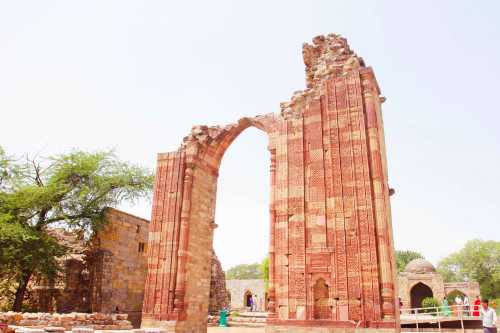Popular Trip Moments
Discovering Serenity in the Heart of Delhi: Safdarjung Tomb | Isa Khan’s Tomb: A Hidden Jewel in the Shadow of Mughal Grandeur | Discovering Isa Khan’s Tomb – A Hidden Mughal-Era Gem in Delhi | Timeless Echoes of Qutub Minar: A Journey into Delhi’s Majestic Past | Timeless Grace at Humayun’s Tomb: A Journey Through Mughal Majesty | Rediscovering Legacy: A Walk Through Isa Khan’s Tomb | Timeless Majesty at Humayun’s Tomb, Delhi | Timeless Beauty in Stone – My Visit to Humayun’s Tomb | Rediscovering History at the Majestic Red Fort | The Taj Mahal Hotel: A Luxurious Experience in New Delhi | Air India flight review to Leh Ladakh 🇮🇳☺️ | EP.1 Kashmir Trip What time will I become a tourist? 🇮🇳 | 5 recommended spots around New Delhi | The Tale of The Imperial Red Fort 🐉 | New Delhi Travel Guide: A Wild Adventure of Curry, Ancient Sites, and Auto-rickshaws | Vibrant New Delhi 💛🤍 | India - Stay at Welcomhotel by ITC Hotels, Dwarka, New Delhi | Enjoy Sports Events at Delhi's Largest Stadium! | A magnificent ruin built in the 14th century! A fort filled with historical romance. | Delhi's oldest Islamic architectural site! | Learn more about Indian traditional crafts and culture🇮🇳 | A moment of calm in a peaceful Buddhist garden⛲️ | India's largest zoo for families to enjoy | A relaxing park surrounded by greenery in India 🇮🇳 | An oasis in Delhi where history and nature come together | An outdoor market where you can enjoy handicrafts and street food from all over India 🇮🇳 | Following in the footsteps of India's first Prime Minister Jawaharlal Nehru 🇮🇳 | The place where Mahatma Gandhi spent his last moments | A must-see museum for railway enthusiasts, where you can learn about the history of Indian Railways. | A comfortable and luxurious stay near the airport ✈️🏨
Popular Travel Types
Recommended Attractions at Popular Destinations
Bangkok attraction near me | Manila attraction near me | Tokyo attraction near me | Taipei attraction near me | Hong Kong attraction near me | Seoul attraction near me | Kuala Lumpur attraction near me | Los Angeles attraction near me | Shanghai attraction near me | New York attraction near me | Shenzhen attraction near me | Osaka attraction near me | Singapore attraction near me | London attraction near me | Guangzhou attraction near me | San Francisco attraction near me | Beijing attraction near me | Macau attraction near me | Bali attraction near me | Jakarta attraction near me | Paris attraction near me | Ho Chi Minh City attraction near me | Istanbul attraction near me | Phuket attraction near me | Chicago attraction near me | Seattle attraction near me | Toronto attraction near me | Orlando attraction near me | Cebu attraction near me | Chiang Mai attraction near me
Popular Restaurants in Delhi
Bukhara | Gulati Restaurant, Pandara Road | Khan Chacha(Connaught Place) | United Coffee House | Sagar Ratna | The Spice Route | Saravana Bhavan | Kiyan | K3 - New Delhi's Food Theatre | Pindi | Dum Pukht | Tian - Asian Cuisine Studio | Dakshin | K & K | Lodi The Garden Restaurant | Tamra Restaurant | Kheer | Keventer's(Select Citywalk Mall) | Spicy Duck | 24/7 | Veda | The China Kitchen | Zizo | Karim's | Ottimo At The West View | Nirulas | Baluchi - A Pan Indian Destination | Orient Express | Jamavar | Olive Bar & Kitchen
Popular Ranked Lists
Popular Luxury Hotels Near Sandakan Division | Popular Best Things to Do in Sheyang | Top 3 Best Things to Do in Fuding | Popular Luxury Hotels Near Odiaxere | Popular Premium Hotels in Mobile County | Top 8 Best Things to Do in Reykjavik | Top 3 Local Restaurants in Tongling | Popular Luxury Hotels Near Sandakan | Top 9 Local Restaurants in Lushan | Popular Best Things to Do in Ninghai | Top 8 Local Restaurants in Jingzhou | Popular Premium Hotels in La Quinta | Top 5 Best Things to Do in Tonghua | Top 6 Best Things to Do in Fenghuang | Popular Premium Hotels in Fahaheel | Top 3 Best Things to Do in Yuyao | Popular Luxury Hotels Near Bridgewater | Top 6 Local Restaurants in Benxi | Top 10 Local Restaurants in Zhangjiagang | Top 10 Local Restaurants in Zaozhuang | Top 10 Local Restaurants in Zhaoqing | Top 10 Local Restaurants in Pengshui County | Top 18 Best Things to Do in Nha Trang | Top 8 Local Restaurants in Anshan | Top 10 Best Things to Do in Naha | Popular Premium Hotels in Maggona | Popular Luxury Hotels Near Phuc Yen | Top 5 Local Restaurants in Jianshui | Popular Premium Hotels in Central Saanich | Top 7 Local Restaurants in Qingzhou
Payment Methods
Our Partners
Copyright © 2025 Trip.com Travel Singapore Pte. Ltd. All rights reserved
Site Operator: Trip.com Travel Singapore Pte. Ltd.
Site Operator: Trip.com Travel Singapore Pte. Ltd.





















